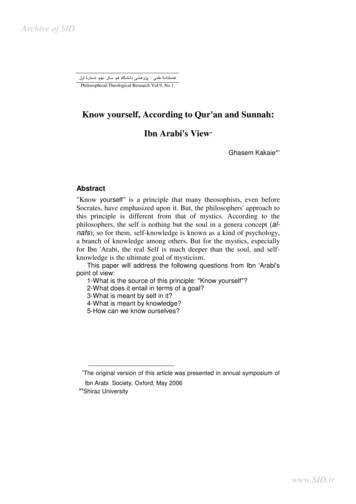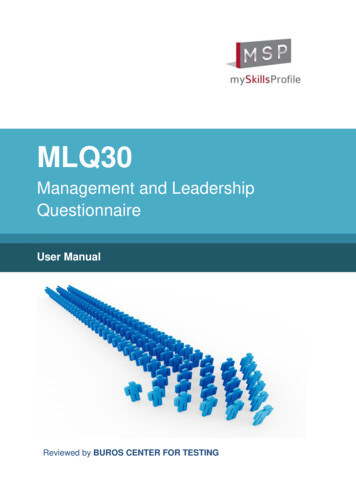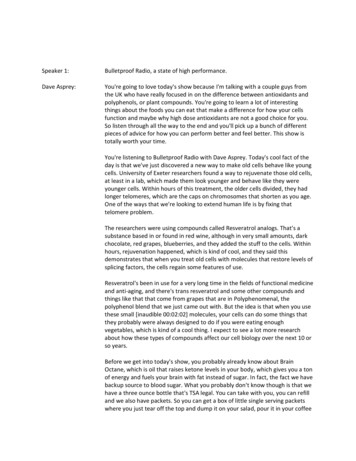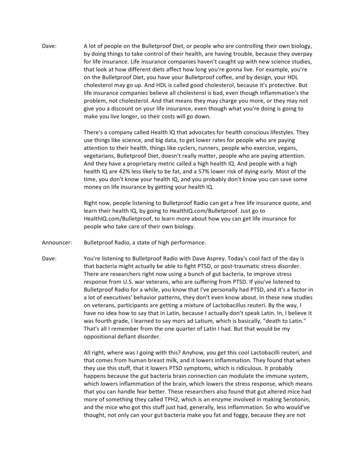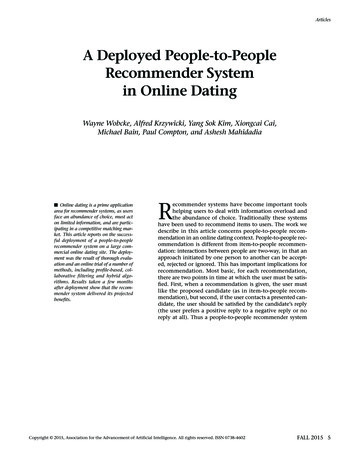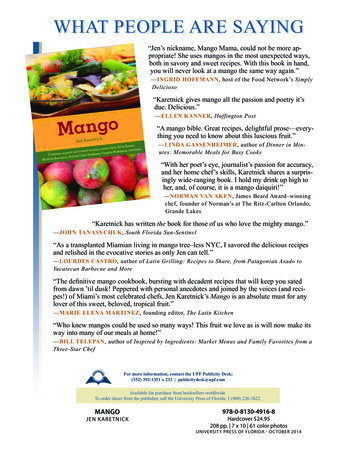
Transcription
WHAT PEOPLE ARE SAYING“Jen’s nickname, Mango Mama, could not be more appropriate! She uses mangos in the most unexpected ways,both in savory and sweet recipes. With this book in hand,you will never look at a mango the same way again.”—INGRID HOFFMANN, host of the Food Network’s SimplyDelicioso“Karetnick gives mango all the passion and poetry it’sdue. Delicious.”—ELLEN KANNER, Huffington Post“A mango bible. Great recipes, delightful prose—everything you need to know about this luscious fruit.”—LINDA GASSENHEIMER, author of Dinner in Minutes: Memorable Meals for Busy Cooks“With her poet’s eye, journalist’s passion for accuracy,and her home chef’s skills, Karetnick shares a surprisingly wide-ranging book. I hold my drink up high toher, and, of course, it is a mango daiquiri!”—NORMAN VAN AKEN, James Beard Award–winningchef, founder of Norman’s at The Ritz-Carlton Orlando,Grande Lakes“Karetnick has written the book for those of us who love the mighty mango.”—JOHN TANASYCHUK, South Florida Sun-Sentinel“As a transplanted Miamian living in mango tree–less NYC, I savored the delicious recipesand relished in the evocative stories as only Jen can tell.”—LOURDES CASTRO, author of Latin Grilling: Recipes to Share, from Patagonian Asado toYucatecan Barbecue and More“The definitive mango cookbook, bursting with decadent recipes that will keep you satedfrom dawn ’til dusk! Peppered with personal anecdotes and joined by the voices (and recipes!) of Miami’s most celebrated chefs, Jen Karetnick’s Mango is an absolute must for anylover of this sweet, beloved, tropical fruit.”—MARIE ELENA MARTINEZ, founding editor, The Latin Kitchen“Who knew mangos could be used so many ways! This fruit we love as is will now make itsway into many of our meals at home!”—BILL TELEPAN, author of Inspired by Ingredients: Market Menus and Family Favorites from aThree-Star ChefFor more information, contact the UPF Publicity Desk:(352) 392-1351 x 233 publicitydesk@upf.comAvailable for purchase from booksellers worldwide.To order direct from the publisher, call the University Press of Florida: 1 (800) 226-3822.MANGOJEN KARETNICK978-0-8130-4916-8Hardcover 24.95208 pp. 7 x 10 61 color photosUNIVERSITY PRESS OF FLORIDA - OCTOBER 2014
Credit: Sands PhotographyFood critic, poet, and educator JEN KARETNICK is the award-winning author/editor of eleven books, including the cookbook Raw Food/Real World(with Sarma Melngailis and Matthew Kenney) and five volumes of poetry. TheCreative Writing Director for Miami Arts Charter School, she also works as thedining reviewer for MIAMI Magazine; a columnist for Biscayne Times; a localexpert for 10Best/USA Today; and a contributor to online publications includingCityEats.com and TheLatinKitchen.com. Karetnick lives on the last acre of a historic plantation with her husband, two children, three dogs, four cats, and fourteenmango trees.JEN KARETNICKis available for interviews and appearances.UNIVERSITY PRESS OF FLORIDAFor more information, contact the UPF Publicity Desk:(352) 392-1351 x 233 publicitydesk@upf.com
Credit: Sands PhotographyQ & A withJEN KARETNICKauthor ofMango“We were wandering around, getting lost, andfound this beautiful old house sitting on an acrelot at the end of a block-long side street. I didn’teven know about the mango trees at the time. Ithought to myself, ‘Wow, if I could live there, I’dbe happy for the rest of my life.’”When did you know you wanted to write this cookbook?After the first season of picking—pardon me, picking up—mangos, I knew therewas a book in this. I could see the delight in people’s faces when I gave them thefruit, the calculation in the eyes of my friends who are chefs, and even the humorin the misery of collecting the blown fruit. I started writing articles about my adventures with mangos almost immediately.How did you first discover your passion for mangos, and what made them standout from other fruit?I really didn’t know that I had one. I’d never even tasted a freshly picked mango, eaten out of hand. We were simply looking for a house with fruit trees. I wasthinking citrus, because I loved grapefruit, and lemons and limes were alwaysgood to have around, but those were the years that citrus canker had started tospread. I’m fortunate that I wound up with mangos, because they remind me ofpeaches, which I grew up loving in New Jersey, and have fond memories of goingto orchards to pick. They’re also a lot more versatile than people think and can gosavory or sweet, and can be eaten green or dried. In addition, they freeze well. I’vediscovered since those very naïve days that I actually don’t like a few tropical fruits,among them papaya and mamey sapote. The textures of those fruits make me gag.Had I moved into Papaya House, I probably would have moved out by now!
Mango House was built in the 1930’s and has trees just as old – how did you acquire this historic home and grove?My husband was fresh out of his medical residency and had just been hired by hispractice. We had one child, a two-year-old girl, and a baby boy on the way. Wewere living in a townhouse on South Beach at the time, so it was clear we’d needmore space, a more conducive atmosphere for raising kids, and a middle pointbetween the two hospitals he was going to be bouncing between. This tiny villageof Miami Shores was it. We were wandering around, getting lost, and found thisbeautiful old house sitting on an acre lot at the end of a block-long side street. Ididn’t even know about the mango trees at the time. I thought to myself, “Wow, if Icould live there, I’d be happy for the rest of my life.” Then we found out how muchit cost. Long story short, we chose a different house and the deal fell through.The same thing happened to the second house we found! That’s when our Realtorcalled us and told us that Mango House had gone off the market and come back on 200,000 cheaper. We couldn’t believe it. We were the first ones in the door.Do you remember the first mango dish you prepared with your homegrownmangos?Salsa. Mango salsa. That first summer, I made vats of it. Jon made huge amounts offrozen daiquiris. We threw open house parties every weekend, getting to know ourneighbors, inviting our friends from South Beach to come pick mangos and swimin the pool, just basically relaxing and watching the mangos fall in a kind of stupefied wonder.This book really shows the versatility of this fruit. What is your favorite way toeat a mango?One of my favorite ways to eat a mango is actually one of the simplest. I like a bigscoop of vanilla ice cream or frozen yogurt, topped with freshly cut-up mango—warm from the tree is the best so you get those variances between temperatures—and sprinkled with granola. Any kind of store-bought ice cream and granola willdo, but I actually prefer that the ice cream be on the milkier rather than the richside. It’s a light dish that should showcase the fruit. I’ve been known to have thisfor dinner. Several bowls of it. For days on end.Can you tell us about the “Mango Gang” and how they have influenced thiscookbook?The Mango Gang were all young chefs experimenting with fusion techniques when
I moved to Miami in 1992. It was Norman Van Aken, Mark Militello, Allen Susserand Douglas Rodriguez. They all had their own take on it, but they were basicallyincorporating the local and seasonal tropical ingredients and incorporating theLatin and Caribbean methods—which themselves were influenced by Asian andAfrican techniques—to create some very tasty and yet high-end fare. I was entranced with them, as many were. It was Norman who set me on the idea of writing a cookbook.Your recipes in Mango are easy to follow, which is beneficial to a chef at any skilllevel. Do you have a sentence of advice for beginner chefs?Don’t be afraid to try—there’s no judgment here. I don’t have good knife skillseither!Is there a question you wish we would have asked you?Some people have been asking me, why publish a book when there’s so manyrecipes available online? Why not just put your recipes online? Maybe I’m just oldschool, but I like having a book open on my counter, getting it dusted with flour,cracking the spine, staining it with oil. It feels like work. Cooking with an iPadfeels antiseptic. Plus, what’s going to happen to a book when one of my cats jumpson the counter and pushes off the book before I can reach her? Nothing. But aniPad? That’s a 400 oops!
MangoJen Karetnickproof
ContentsIntroduction 0001. Taking Mangos in Hand: How to Select, Cut, and Keep 0002. Drinks 0003. Breakfast 000proof4. Appetizers and Snacks 0005. Soups, Salads, and Dressings 0006. Main Dishes: Sea 0007. Main Dishes: Land 0008. Side Dishes 0009. Salsas, Chutneys, Pickles, and Sauces 00010. Sweets 000Acknowledgments 000Appendix. Can’t Get Enough: Growing Your Own, Buying Fruit, and MangoFestivals 000Index 000
Appetizers and SnacksMango Florida Lobster CevicheBy Douglas Rodriguez“This method of blanching Florida lobster assures that it won’t beovercooked, and it creates a nice, soft texture for the ceviche,” ChefRodriguez says. Works for me. I’ve dined on this in Doug’s restaurants andat home and I’m wowed every time. As Chef says, “Buen provecho!”For the lobster:6 Florida lobster tails1 gallon water3 tablespoons saltIn a large pot, bring the salt and water to boil. After water is boiled, removefrom heat and place the lobster tails in the hot water. Cover pot and leavefor 10 minutes. Then remove the lobster tails from the pot and let themcool in the refrigerator.For the vinegar:proof1 pound ginger, peeled and grated2 cups white vinegar1 cup sugarPlace the ginger, vinegar, and sugar in a pot. Bring to a simmer over verylow heat. Let steep about 30 minutes, then strain and reserve after vinegarcools.For the ceviche sauce:Juice of 6 limesZest of 3 limes1 mango, peeled and puréed2 tablespoons yuzu koshu (see text box)1 bunch cilantro, julienned1 bunch chives, sliced on a bias1 tablespoon Espelette pepper (see text box)4 ripe mangos, peeled and sliced57
58MangoRemove the lobster from the shells and slice into medallions; reserve in abowl.In a blender, add ½ cup of the prepared vinegar, lime juice, zest, mangopurée, yuzu koshu, and salt and pour over the lobster. Add the chives andcilantro, then sprinkle with the Espelette pepper.To plate, place the sliced mangos in between the lobster medallions.Serves 6proof
Appetizers and SnacksDouglas RodriguezIn The Great Ceviche Book, Cuban-American author Douglas Rodriguez, thechef/restaurateur credited with launching the Nuevo Latino movement, firstat Miami’s Yuca and later at New York’s Patria, quips, “Ceviche has the samehealth-conscious allure of sushi . . . I suspect it won’t be too long before consumers start seeing containers of ceviche right next to the lines of Californiarolls in their grocer’s refrigerated cases.”proof(continued)59
(continued)Rodriguez should know. Now chef-owner of De Rodriguez Cuban on Oceanin Miami (along with Alma de Cuba in Philadelphia), the Godfather of NuevoLatino Cuisine is an acknowledged ceviche expert. “[Sushi and ceviche] aresingle ingredient-driven dishes. They’re Zen. The other ingredients exist to enhance the flavor of that one main thing.”Keeping harmony and minimalism in mind, Chef Rodriguez effectively cullselements of each to create a crossover specialty. “Ceviches can be too overpowering. They benefit from the Asian mentality of balance,” he elaborates. Asa result, recipes like his “Mango Florida Lobster Ceviche” neither overwhelm thepalate with spiciness nor soften it with sweetness.Chef Doug and his wife, Nelly, who is a charming hostess, perfectly balanceeach other—just like the ingredients of a good ceviche. Also friends and neighbors in Miami Shores, the Rodriguez family practically has a mango endowment; come summer, the menus at De Rodriguez are stuffed with fruit.proofYuzu KoshuYuzu koshu is a Japanese condiment comprising citrus (yuzu) peel, chili peppers, and salt. It is a rough, fermented paste that is at once tart and spicy, witha distinct flavor that can be quite addictive. You can substitute mango powdermixed with cayenne powder and salt if you can’t find yuzu koshu in a Japanesemarket.Espelette PepperThis dried, ground red pepper is distinct in the cuisine of the northern Basqueregion. The variety is treasured by the French who live in this particular area, atiny village called Espelette, in the Pyrénées-Atlantiques region in southwestFrance. If you can’t find this particular pepper, substitute cayenne.
62MangoMussels ChorizoBy Chef Irie Spice¼ cup olive oil1 shallot, chopped2 teaspoons chopped garlic1 teaspoon finely chopped Scotch bonnet pepper2 teaspoons fresh thyme leaves1 cup diced ripe mango½ cup diced chayote squash1 cup Spanish chorizo30–40 fresh black Mediterranean mussels, washed2 cups white wine3 tablespoons butter¼ cup chopped cilantroSalt and pepper to tasteproofAdd the oil to a pan on medium heat, then add the shallots and sauté forabout 1 minute. Add the garlic, pepper, and thyme. Sauté for about 2 minutes, then add the mango and chayote. Sauté for another minute beforeadding the chorizo.Cook for about 2 minutes, then add the mussels to the pan. Spread themout and add the white wine. Cover the pan and reduce the heat to let themussels steam for about 5 minutes. Add the butter and chopped cilantroand cook for another minute. Check the seasoning, then remove from theheat. Discard any mussels that haven’t opened and serve.A Different Cultivar: Chef Irie recommends serving this with mango aioli and a couple of slices of toasted baguette bread. If you buy a bottle ofultra-reasonably priced Chilean or New Zealand Sauvignon Blanc and apack of sausages at your local supermarket for a few dollars and throw ina tossed salad, you’ve got a high-quality, quick-to-make meal that can feedsix people for around 20.
Soups, Salads, and DressingsFarfalle Salad with Shaved Fennel, Fresh Peas,Quartered Artichokes, and Mango-DijonnaiseWe don’t eat a lot of pasta in my house, simply because my husband anddaughter are gluten intolerant. It is possible to make this salad with ricepasta or some other wheat-free noodle. But I love how the farfalle cradlethe baby peas, and have yet to find a gluten-free version. So I’m greedy, andmake it for my son, Remy, and me. Of course, once I find a decent, wheatfree farfalle, I’ll be preparing this dish for my whole family to enjoy.10 ounces farfalle (substitute other pasta style or shape of choice)1 tablespoon olive oil1 stalk fennel, shaved1 cup fresh baby peas, cooked12 marinated, quartered artichoke hearts, drained3 stalks green onion, green part only, chopped3 carrots, heirloom or multicolored if possible, sliced1½ cups Mango-Dijonnaise (page 000)Salt and pepper to tasteproof95
96MangoCook the pasta according to directions on the package. When al dente,drain and dump into a bowl. Immerse bowl in a larger bowl filled with water and ice to stop the pasta from continuing to cook. Add oil to the pastaand toss to keep from sticking together. Do not rinse pasta under runningwater as it washes away the starches that help the dressing cling to it.When the pasta has cooled to room temperature, add the fennel, peas,artichoke hearts, green onion, and carrots. Fold in Mango-Dijonnaise andtoss lightly. Salt and pepper to taste. Serve immediately or cool in the refrigerator for service at another time. If reserving from the refrigerator,allow the salad to come to room temperature first. The pasta and dressingflavors taste better when they are warm. But don’t heat them or they willbreak down.A Different Cultivar: You can also dress this salad with Mango Vinaigrette(page 000) for a lighter-tasting salad.proof
Main Dishes: SeaVanilla-Scented Black Grouper Cheeks with FujiApple-Mango Sabayon Foam, Mustard Seed Pickled Mango,and Himalayan Pink Salt–Israeli Pumpkin Seed PestoBy Michael R. ShikanyThis may appear to be the most complicated recipe in the book, but thatdoesn’t mean you shouldn’t attempt it. For ease, think of it as three recipes,and begin by pickling the mango and making the pesto, both of which canbe done in advance. Don’t be intimadated by the sabayon—a mousse-likesauce—or the equipment you need, either; you can substitute a doubleboiler for a bainmarie and use a whipped cream canister for the foam. Thenthe final steps will be a snap—just like eating it!½ pound unsalted butter1 vanilla bean6 egg yolksJuice of 3 Fuji applesJuice of 3 mangos8 black grouper cheeks, cleanedSalt and white pepper to tasteMustard Seed Pickled Mango (recipe follows), strained and patted dryHimalayan Pink Salt–Israeli Pumpkin Seed Pesto (recipe follows)4 sprigs of basil for garnishproof107
108MangoIn a saucepan, place the unsalted butter. Cut the vanilla bean in half andadd to the butter. Over low heat, melt the butter, skimming the milk solidsfrom the top. Do not stir. Infuse the butter for 2 hours and strain thougha chinois. You will also notice milk solids in the bottom of the pan; do notdump into the chinois. Set aside.Bring a double boiler to a simmer and cover with a large mixing bowl.Add the egg yolks and begin to whisk vigorously. Slowly incorporate theapple-mango juice into the yolks while still whisking; do not pour in toofast or your sabayon with break. The sabayon is ready when you can formribbons with the liquid almost like a soft, foamy pudding. Take off theheat. Add the sabayon to a foam charger and place in a bainmarie to keepwarm.In a sauté pan, add the vanilla clarified butter and warm on high heat.Season the grouper cheeks with salt and white pepper. Brown on both sides.With a food brush paint the bottom of the plate with the pesto at a diagonal. Place one cheek flat on top of the pesto and another one on top ata bias. With your foam charger, dispense the sabayon north and south ofthe diagonal pesto paint. Sprinkle the plate with the pickled mango cubesand garnish with a sprig of basil. Serve immediately.Serves 4proofMustard Seed Pickled MangoBy Michael R. Shikany2 cups waterJuice of 1 lemon⅓ cup kosher salt1½ tablespoons turmeric2 cups apple cider vinegar½ cups white wine vinegar½ cup sugar1 tablespoon mustard seed½ teaspoon dry mustard½ tablespoon dry chili flakes1 clove1 bay leafSea salt and white pepper to taste2 mangos, peeled and cubed
Main Dishes: SeaJerked Grouper with Mango-Fig ChutneyBy Kareem Anguin of The Oceanaire Seafood Room in Mary Brickell Village1 tablespoon soy sauce2 cloves garlic2 Scotch bonnet peppers6 tablespoons allspice6 sprigs thyme4 tablespoons dark rum2 8-ounce grouper filletsMango-Fig Chutney (recipe follows)Combine all the ingredients except the grouper in a blender and blend untilsmooth. Pour liquid over grouper and let it sit for 2 hours.Remove grouper from liquid and place on a sheet pan. Bake for 20 minutes at 300 . Transfer to 2 plates and top with Mango-Fig Chutney. Serveimmediately.Serves 2proof111
112MangoKareem AnguinHailing from Jamaica, thirty-something Chef Kareem is the second-youngestExecutive Chef/Operating Partner in the Oceanaire (http://www.theoceanaire.com) chain. Anguin brings his Caribbean influences—including mangos, naturally—to all of his Oceanaire culinary creations, which include braised oxtail,short ribs with wasabi mash, lobster risotto, citrus sweet potato, shrimp andgrits, and tempura Alaskan king crab. Humble and unassuming, Anguin lovesto work with teens, teaching them how food preparation can be used to inspirecreativity and passion—which makes him okay not just in my mango book, butin any of my books.proof
Main Dishes: SeaMango-Fig ChutneyBy Kareem Anguin of The Oceanaire Seafood Room in Mary BrickellVillage2 cups white balsamic vinegar2 tablespoons brown sugar1 mango, diced1 red bell pepper, seeded and diced1 Scotch bonnet pepper, seeded and diced2 tablespoons chopped figs½ bunch cilantro, rough cutIn a saucepan, combine the vinegar, brown sugar, mango, bell pepper,and Scotch bonnet pepper. Cook over low heat for 15 minutes. Strainand reserve the liquid separately from mangos and peppers. Refrigerate liquid and mango-pepper combination for 30 minutes.In a new bowl, combine the figs, cilantro, and mango-pepper mixture. Add 3 ounces of the strained liquid back in and mix well.proofMakes about 1½ cups.113
recipes available online? Why not just put your recipes online? Maybe I’m just old school, but I like having a book open on my counter, getting it dusted with flour, cracking the spine, staining it with oil. It feels like work. Cooking with an iPad feels antiseptic. Plus, w


